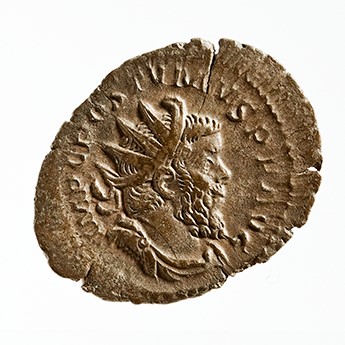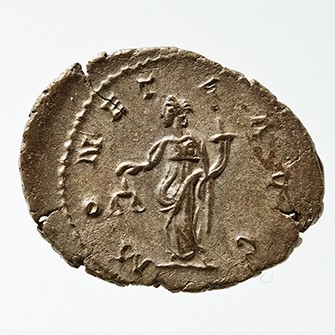Title: Antoninianus of Postumus - 1966.64
Acquisition number: 1966.64
Author or editor: Beryl Rawson
Culture or period: Roman Imperial
Date: AD 262-265
Material: Metal - Copper-silver alloy
Object type: Coins - Roman
Dimensions: 25mm (w)
Origin region or location: Germany
Origin city: Cologne
Display case or on loan: 7
Keywords: Coin, antoninianus, Roman, Imperial, Postumus, Moneta, Gaul
Sear, D.R., Roman Coins and their Values 5 vols (London, Spink, 2000-2014) 10962; Seaby, H.A., Roman Silver Coins (London, B.A. Seaby, 1967) IV 199.
1966.64
Antoninianus of Postumus
3.508 g. AD 262-265
Obv.: Bust of Postumus r., radiate, draped, bearded. IMP(erator) C(aesar) POSTVMVS P(ius) F̣(elix.) AVG(ustus).
Rev.: Moneta standing draped l. with scales in her right hand and cornucopiae in her left. MONETA AVG(usti).
The Roman commander in Gaul, Postumus, led a revolt in AD 259 and established himself as emperor in Gaul until he was murdered by his troops in 268. This coin was probably struck at his mint in Cologne (or perhaps Lugdunum).
Moneta was originally a surname of Juno, but because the temple of Juno Moneta at Rome was for some time the mint of Rome, moneta came to mean a mint. The right to issue coinage was an important imperial prerogative which Postumus is here claiming for himself. The scales and cornucopiae are to symbolise the abundance and accuracy of the imperial mint. The presence of the scales shows that the value of the coinage was still thought of in terms of its weight.
Sear, D.R., Roman Coins and their Values 5 vols (London, Spink, 2000-2014) 10962; Seaby, H.A., Roman Silver Coins (London, B.A. Seaby, 1967) IV 199.

